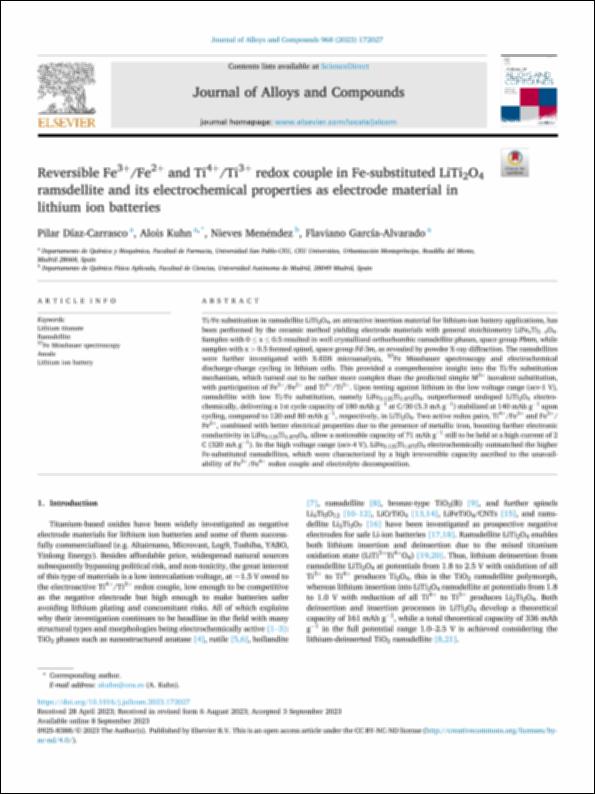Por favor, use este identificador para citar o enlazar este ítem:
http://hdl.handle.net/10637/14612Reversible Fe3+/Fe2+ and Ti4+/Ti3+ redox couple in Fe-substituted LiTi2O4 ramsdellite and its electrochemical properties as electrode material in lithium ion batteries
| Título : | Reversible Fe3+/Fe2+ and Ti4+/Ti3+ redox couple in Fe-substituted LiTi2O4 ramsdellite and its electrochemical properties as electrode material in lithium ion batteries |
| Autor : | Díaz Carrasco, Pilar Kuhn, Alois Karl Menéndez, Nieves García Alvarado, Flaviano |
| Materias: | Lithium titanate; Ramsdellite; Anode; Lithium ion battery |
| Editorial : | Elsevier |
| Citación : | Pilar Díaz-Carrasco, Alois Kuhn, Nieves Menéndez, Flaviano García-Alvarado, Reversible Fe3+/Fe2+ and Ti4+/Ti3+ redox couple in Fe-substituted LiTi2O4 ramsdellite and its electrochemical properties as electrode material in lithium ion batteries, Journal of Alloys and Compounds, Volume 968, 2023, 172027, ISSN 0925-8388, https://doi.org/10.1016/j.jallcom.2023.172027 |
| Resumen : | Ti/Fe substitution in ramsdellite LiTi2O4, an attractive insertion material for lithium-ion battery applications, has been performed by the ceramic method yielding electrode materials with general stoichiometry LiFexTi2 xO4. Samples with 0 ≤ x ≤ 0.5 resulted in well crystallized orthorhombic ramsdellite phases, space group Pbnm, while samples with x > 0.5 formed spinel, space group Fd-3m, as revealed by powder X-ray diffraction. The ramsdellites were further investigated with X-EDS microanalysis, 57Fe M¨ossbauer spectroscopy and electrochemical discharge-charge cycling in lithium cells. This provided a comprehensive insight into the Ti/Fe substitution mechanism, which turned out to be rather more complex than the predicted simple M3+ isovalent substitution, with participation of Fe3+/Fe2+ and Ti4+/Ti3+. Upon testing against lithium in the low voltage range (ocv-1 V), ramsdellite with low Ti/Fe substitution, namely LiFe0.125Ti1.875O4, outperformed undoped LiTi2O4 electrochemically, delivering a 1st cycle capacity of 180 mAh g 1 at C/30 (5.3 mA g 1) stabilized at 140 mAh g 1 upon cycling, compared to 120 and 80 mAh g 1, respectively, in LiTi2O4. Two active redox pairs, Ti4+/Fe3+ and Fe3+/ Fe2+, combined with better electrical properties due to the presence of metallic iron, boosting farther electronic conductivity in LiFe0.125Ti1.875O4, allow a noticeable capacity of 71 mAh g 1 still to be held at a high current of 2 C (320 mA g 1). In the high voltage range (ocv-4 V), LiFe0.125Ti1.875O4 electrochemically outmatched the higher Fe-substituted ramsdellites, which were characterized by a high irreversible capacity ascribed to the unavailability of Fe3+/Fe4+ redox couple and electrolyte decomposition. |
| URI : | http://hdl.handle.net/10637/14612 |
| Derechos: | http://creativecommons.org/licenses/by-nc-nd/4.0/deed.es OpenAccess |
| ISSN : | 0925-8388 |
| Cubierto por: | Acuerdo Transformativo - 2023 |
| Fecha de publicación : | 8-sep-2023 |
| Centro : | Universidad San Pablo-CEU |
| Aparece en las colecciones: | Facultad de Farmacia |
Los ítems de DSpace están protegidos por copyright, con todos los derechos reservados, a menos que se indique lo contrario.


